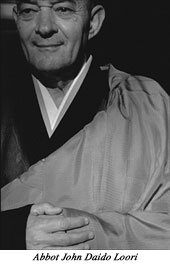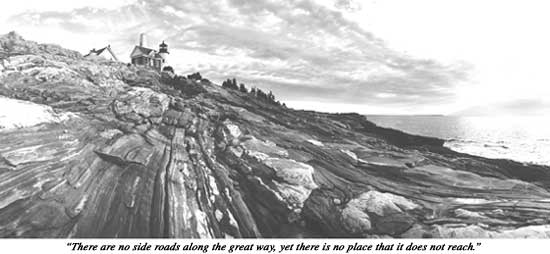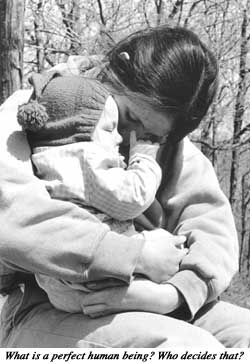Zhaozhou’s Buddha
Dharma Discourse by Abbot John Daido Loori
Master Dogen's 300 Koan Shobogenzo,* Case 80
Featured in Mountain Record 18.3, Spring 2000
Once a monastic bid farewell to Zhaozhou. Zhaozhou said, "Where are you going?" 1 The monastic said, "I will visit various places to study the Buddha-dharma." 2Zhaozhou picked up his whisk and said, "Do not abide in a place where there is a Buddha. 3Pass by quickly a place where there is no Buddha. 4Upon meeting someone do not misguide that person." 5The monastic said, "That being the case, I will stay here." 6Zhaozhou said, "Pick up the willow blossoms." 7
The Commentary
Zhaozhou, seeing this monastic teetering on the edge, lost no time in precipitating the situation. Finding no place to abide, the monastic was stopped dead in his tracks. Again the old bodhisattva pulled the rug out from under him. Do you understand? There are no side roads along the great way, yet there is no place that it does not reach. The truth of the way is not in seeing or hearing nor is it in words and ideas. If you can cut through the entanglements and untie the bonds of the Buddhas and ancestors, you have discovered the land of clarity and peace where even heaven and hell cannot reach. If you seek it from others, you go astray. If you seek it within, you are far removed from it. What will you do?
The Capping Verse
This old Buddha has a way of teaching:
Thirty blows of the stick without raising a hand.
Directing yourself toward it, you move away from it.
What person’s life is lacking?
1. In coming and going, Zen practitioners reveal much about their practice.
2. From California to New York, looking for his head.
3. It only creates complications.
4. A forest of brambles.
5. Do not deceive yourself; do not deceive others.
6. Look, he wants to create a nest.
7. Do not just sit there. Do something.
Footnote: *300 Koan Shobogenzo is a collection of koans gathered by Master Dogen during his study in China. The koans from this collection, often called the Chinese Shobogenzo, appear extensively in the essays of Dogen’s Japanese Shobogenzo. These koans have not been available in English translation but are currently being translated and prepared for publication by Kazuaki Tanahashi and Abbot John Daido Loori. Abbot Loori has added a commentary, capping verse, and footnotes to each koan.

Many koans begin with an apparently innocent question like the one Zhaozhou poses to this monastic. "Where are you going?" Simple enough. Yet in the question there is a challenge to articulate the deepest truth of one’s life, at this particular moment, in this encounter. In asking, Zhaozhou, like any worthy teacher, probes and invites. Seeing that the monastic in front of him is teetering on the edge, he loses no time in precipitating a situation that will allow the student to clarify his search.
What is the edge on which this monastic teeters? He has reached a point in his study with Zhaozhou where he is ready to depart. Where are you going? Zhaozhou asks. In the footnote for that line, I comment, In coming and going, Zen practitioners reveal much about their practice. Where are you going? Where are you from? These inquiries can be understood literally, "What is the physical place you are coming from," or they can be appreciated as questions pertaining to the most fundamental truths: "What is the deepest source of your being? Who are you? What is your understanding of reality, life, death?" When Zhaozhou asks, "Where are you going?" it is not a casual question. It is a test of the monastic’s understanding, and an opportunity for him to see clearly. The monastic said, "I will visit various places to study the Buddha-dharma." The footnote to that says, From California to New York, looking for his head. What is he searching for? What is this Buddha-dharma that he is seeking? Where is it?
Zhaozhou responds, Do not abide in a place where there is a Buddha. The footnote says, It only creates complications. Why would going to a place that has a Buddha create complications? Buddha means "enlightened one," "realized being," "clear and perfect." Why should anyone avoid a place like that? What is Zhaozhou’s intent in giving him that kind of advice? Then he adds, Pass by quickly a place where there is no Buddha. The footnote elaborates, A forest of brambles. Clearly, where there is no Buddha, there is a forest of brambles, the world of delusion. Here Zhaozhou’s instruction is understandable. But why does he advocate, "Pass by the place where there is a Buddha?"
Consider the possibility, as the monastic most certainly did, of bringing both of Zhaozhou’s pointers together. If you avoid the place where there is Buddha and you avoid the place where there is no Buddha, what remains? In another translation of this exchange, the monastic, exasperated, cries out, "That means there is nothing I can rely on." Most certainly. In this translation, the monastic says, That being the case, I will stay here. I will not go.
In addition to advising, Do not abide in a place where there is a Buddha and Pass by quickly a place where there is no Buddha, Zhaozhou continues, Upon meeting someone do not misguide that person. The footnote says, Do not deceive yourself; do not deceive others. If you are deceived, then what you speak is deception. If you are clear, then what you speak is clarity. The monastic said, "That being the case, I will stay here." The footnote says, Look, he wants to create a nest. That is what we do when we do not know what to do. We stop and create a nest. We make ourselves comfortable, avoiding edges and risks, not reflecting on who we are and what this life is. At this point, Zhaozhou exhorts, Pick up the willow blossoms. The footnote echoes, Do not just sit there. Do something.
The commentary begins with Zhaozhou, seeing this monastic teetering on the edge, lost no time in precipitating the situation. I like the word "precipitating." Originally, it was a technical word used in chemistry. Precipitation is used to crystallize out of a solution one of the components of the mixture. But crystallization does not happen spontaneously. It usually necessitates a seed. The seed in crystallization is sometimes a small particle of that same crystal. Putting a bit of the pure substance into a solution will cause a chain reaction where the crystalline form of that particular compound will settle out. Another way of precipitating crystallization is to scratch the side of a beaker with a glass rod. A few scratches and suddenly crystals start to appear. Scratching seems like a very odd way to get crystals to form, but it works. Using a shout or a blow is an odd way to get someone to come to realization. You would think that explaining might be more helpful. As it happens, explaining is the least effective way of bringing someone to realization. Explaining creates an intellectual understanding. I am talking about realization. Understanding is not realization. Realization is a whole-body-and-mind experience.
Zhaozhou, scratching the container, precipitated the situation with this monastic. His scratching was, Do not abide in a place where there is a Buddha. Pass by quickly a place where there is no Buddha. On meeting someone, do not misguide that person. As the commentary states, Finding no place to abide, the monastic was stopped dead in his tracks. If I shouldn’t go here and I shouldn’t go there, where will I go? What will I do? I just better stay here. But Zhaozhou does not let up. "Pick up the willow blossoms." The commentary says, The old bodhisattva pulled the rug out from under him. Do you understand? Pulling the rug out is one of the devices used in teaching the Buddha-dharma. Our tendency is to want to grab on to things. We find comfort and apparent certainty in holding onto things physically and in naming them. But that is not what truth is. So the teacher pulls the rug of certainty out and the student falls. The process continues again and again until the time when the rug gets yanked and the student does not fall. At that time, the student is free.
There are no side roads along the Great Way. There is just one way. There are no branches or detours. Yet there is no place it does not reach. How is that? If the way doesn’t branch out, how is it that there is no place it does not reach? What kind of a path is it? It reaches everywhere, not because there are branches, but because it is all encompassing. It has no boundaries.

The truth of the Way is not in seeing or hearing. If you do not see it or hear it, how will you know it? The truth is not about knowing. It is not in seeing or hearing, nor is it in words and ideas. Then what is it? The Buddha Way is not about understanding; it is about realization.
In our early years of life there is much we learn by direct experience, not through information. An infant doesn’t learn the stove is hot through a lecture from the mother. They have no idea what "hot" means. They touch the stove and learn by direct experience. Somehow, along the way, direct experience is replaced with words and ideas — abstractions of reality. Little by little, our understanding of ourselves and the universe accumulates as a collection of abstractions. We lose touch with the reality we talk about, understand and believe in.
If you can cut through the entanglements and untie the bonds of the Buddhas and ancestors, you have discovered the land of clarity and peace where even heaven and hell cannot reach. This sounds as if buddhas and ancestors are something to be avoided. Why? Buddhas and ancestors are just another idea — more words, notions, and mental constructs. What is reality? It is not out there. All concepts that confine our life need to be cut through. Buddhas and ancestors need to be cut through. When you have cleared all of it out of the way, right there is the land of clarity and peace where even heaven and hell cannot reach. It is non-dual; not two, not buddhas nor ordinary beings. If you seek it from others, you go astray. There is nothing anyone has to give. There is nothing that can be received. Total perfection already exists as each and every one of us.
But what is the meaning of the next line, If you seek it within, you are far removed from it? How is that? How does this relate to the often used phrase, "Look to the light within?" The truth of the Way is not in here. It is not out there. Then where is it? If you seek it from others, you go astray. If you seek it within, you are far removed from it. What will you do? That is the crisis that Zhaozhou so compassionately precipitated for this monastic who was merrily going around, doing what many practitioners in those days were doing — bouncing from place to place, visiting various teachers, never really probing the depths during any of his stops along the way.
Lately there has been a glut of books, magazine articles, television shows and web information with all kinds of forecasts for the next century from scientists and soothsayers. Religious people were not even asked. Most people chose to talk about genetic engineering. Apparently, genetic engineering figures big in our future. And with genetic manipulation becoming more sophisticated, there is serious talk about creating "designer babies." There is thought about, research probably already started on, making the perfect human being.
What is a perfect human being? Who decides that? We have already gone down this path with the perfect orange. The Chinese came up with a seemingly magnificent orange. It looked good, was huge, loaded with juice, but tasteless. I suspect that is how the designer babies will turn out. They will look and feel like television commercials.
What is perfect human nature? It is our Buddha nature — what
we already are, the nature of all sentient and insentient beings. In that case,
what is it that we are seeking? Zhaozhou slams that question in front of this
monastic. What is it that you are seeking? What is it that you are lacking? If
there is anything we need to do as practitioners, now and in the future, it is
to be conscious of that perfect  human
quality that already exists buried beneath layers and layers of conditioning. It
is there. No one lacks it. That was and remains the radical realization of the
Buddha. Do you realize that? The profound statement that the Buddha made when he
saw the morning star was, "I, all sentient beings, and the great earth have at
once entered the Way." This points to the fact that each and every one of us is
perfect and complete, lacking nothing: the short ones, the tall ones, the fat
ones, the thin ones, the crooked ones, the black ones, the gay ones, the female
ones. Every single being — perfect and complete, lacking nothing. That is what
Buddha declared. That is what thousands of Buddhist men and women have realized
for two thousand five hundred years. Each and every generation came home to
their own existence. How can that be improved? What is lacking? What do we have
to add? What do we have to remove? All we need to do is see the ground of being
we are born with. That is the gift of human life.
human
quality that already exists buried beneath layers and layers of conditioning. It
is there. No one lacks it. That was and remains the radical realization of the
Buddha. Do you realize that? The profound statement that the Buddha made when he
saw the morning star was, "I, all sentient beings, and the great earth have at
once entered the Way." This points to the fact that each and every one of us is
perfect and complete, lacking nothing: the short ones, the tall ones, the fat
ones, the thin ones, the crooked ones, the black ones, the gay ones, the female
ones. Every single being — perfect and complete, lacking nothing. That is what
Buddha declared. That is what thousands of Buddhist men and women have realized
for two thousand five hundred years. Each and every generation came home to
their own existence. How can that be improved? What is lacking? What do we have
to add? What do we have to remove? All we need to do is see the ground of being
we are born with. That is the gift of human life.
The Capping Verse:
This old Buddha has a way of teaching:
Thirty
blows of the stick without raising a hand.
Directing yourself toward it,
you move away from it.
What person’s life is lacking?
Thirty blows of the stick is a shocking encounter with a teacher. Instead of wielding the stick Zhaozhou used simple words with just as much impact as thirty blows. Directing yourself toward it, you move away from it. Why? Consider that carefully. The way is right where you stand. Any movement you make to direct yourself toward it is away from where you are.
What person’s life is lacking? Each one of us is perfect and complete, lacking nothing. The pivotal question is, "How do you get to that?" The answer is simple — practice. Practice is not an educational process of collecting reams of information. Practice is exactly the opposite of accumulating data. It involves peeling back layers of conditioning, the ways we have defined our lives, to get to what is underneath that. Buried below those layers of conditioning is a Buddha. That is what needs to be realized. Regardless of what aspect of training we use to get to the ground of being, the fact is that ground is there. Realized or not, it is there.
When we have not yet realized our Buddha nature, we live our lives out of delusion, out of our conditioning. That leads to a lot of pain and suffering. When we realize our Buddha nature, we enter the realm of clarity and peace. The world is the same world. But our way of appreciating ourselves and the universe is transformed. We call that enlightenment. It is true human nature. We do not need genetic designers for it. Nobody can improve this perfection. That is what it means to be a great human being — to truly be human. Most of us have never seen a true human being. We have seen some qualities surface here and there in special people. I have no doubt that true human qualities are not hate, greed, and jealousy, but compassion, wisdom, and love. How this next century goes depends a lot on how much we are able to get in touch with our true humanity. Please take care of this great matter.
John Daido Loori, Roshi is the Abbot of Zen Mountain Monastery. A successor to Hakuyu Taizan Maezumi, Roshi, Abbot Loori trained in rigorous koan Zen and in the subtle teachings of Master Dogen, and is a lineage holder in the Soto and Rinzai schools of Zen.
[Main Case] [Index of Dharma Discourses] [Table of Contents] [Subscription Information]
©2003 Zen Mountain
Monastery
mountains & rivers order | training in the mro | zen mountain monastery | fire lotus zendo |
dharma communications | zen environmental studies
institute | society of
mountains & rivers | the
monastery store | wzen.org | contents | contact us |
All words and images on these pages are protected by
copyright